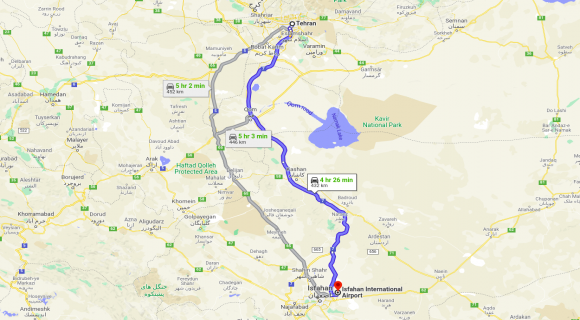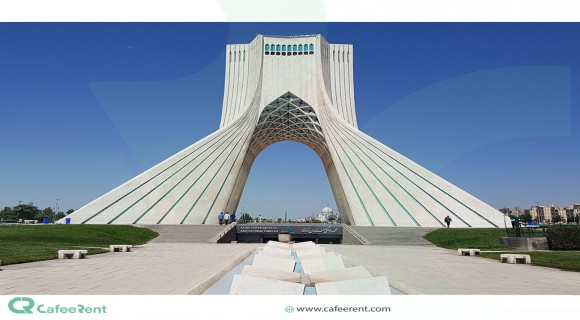Tabriz; the mountainous noble city of Iran

The provincial capital of East Azerbaijan, Tabriz, is located in northwest Iran.
The city has the sixth-highest population in Iran.
Tabriz is located between long ridges of volcanic cones in the Sahand and Eynali mountains, in the Quru River valley, in the historical Azerbaijan region of Iran.
Its elevation is between 4,430 and 5,250 feet above sea level.
A plain that slowly descends to the eastern shores of Lake Urmia, 60 kilometres (37 miles) to the west, emerges from the valley.
Tabriz is regarded as a summer resort because of its chilly winters and mild summers.
The World Crafts Council designated it as the World Carpet Weaving City in October 2015, and the Organization of Islamic Cooperation awarded it the 2018 Exemplary Tourist City.
The major economic centre and metropolitan region in northwest Iran is Tabriz, which has a population of approximately 1.7 million.
The majority of the people speak both Persian and Azerbaijani. Automobiles, machine tools, refineries, petrochemicals, textiles, and cement manufacture all have significant heavy industry hubs in Tabriz.
The city is highly known for its handmade goods, which include jewellery and rugs made by hand.
In all of Iran, the best candies, chocolate, dried fruits, and traditional Tabrizi cuisine are acknowledged.
Some of the most esteemed cultural institutions in Northwest Iran are located in Tabriz, which is also a centre for intellectual activity.
There are numerous historical sites in Tabriz that show the evolution of Iranian architecture throughout the course of its long history.
Ilkhanid, Safavid, and Qajar rule over the majority of Tabriz's historical sites still standing today.
The magnificent Bazaar of Tabriz, which is listed as a World Heritage Site, is one of these places.
Beginning in the early modern age, Tabriz had a crucial role in the growth, trade, and economics of its three adjacent regions: the Caucasus, Eastern Anatolia, and Central Iran.
The city was essential to Iran's history in the modern era.
Many facets of Iran's early modernization had its beginnings in Tabriz because it was the city closest to Europe.
Following two Russo-Persian Wars in the first part of the 19th century, Tabriz was at the vanguard of Iranian sovereignty over its Caucasian possessions before the Qajar dynasty's Caucasian territories were forcibly ceded to Imperial Russia.
The city served as the Qajar royal princes' customary home until 1925.
Etymology
Encyclopaedia Britannica and other sources claim that the name Tabriz is derived from tap-riz, which means "flowing hot" and refers to the region's numerous thermal springs.
According to other sources, King Tiridates II of Armenia defeated Ardashir I of the Sassanid Empire in AD 246 in retaliation for the death of his brother.
He also renamed the city from Shahistan to Tauris, which derives from "ta-vrezh" ("this revenge" in Grabar).
It became the seat of government for Tiridates III, king of Armenia, in AD 297.
However, this myth has a modern provenance; no ancient source mentions such an occurrence.
This is based on the writings of Vardan Areveltsi, an Armenian historian from the 13th century.
As a result, the city's old Armenian name was Tavrezh.
The city of Tabriz and the "ancient fortress of Tarui-Tarmakisa" (or Tarwi-Tarwakisa), which existed in the eighth century BC, are related, according to the Cambridge History of Iran, and Ernst Emil Herzfeld's Archaeological History of Iran also makes this connection (able to overcome).
Some academics, however, think Tabriz might be a pre-Iranian toponym.
recent history
Not much is known about Tabriz's early past.
The earliest evidence of a civilization in the city comes from a first-millennium B.C. Iron Age graveyard that was discovered in the late 1990s on the northern side of the Blue Mosque.
On the epigraph of the Assyrian King Sargon II in 714 BC, the city was also mentioned as Tarui or Tauris.
David Rohl, an Egyptologist, hypothesised that the fabled Garden of Eden existed close to Tabriz.
Regarding Rohl's opinions, archaeologist Eric H. Cline wrote "His recommendations have not been accepted by the academic establishment.
The fact that his reasoning hinges on conjectures about the transfer of place names for numerous rivers and other connected locations from antiquity to the present does not assist.
In the end, Speiser, Zarins, and Sauer's hypotheses seem to be more plausible than Rohl's suggestion, which is still possible but is neither more nor less likely than any other hypothesis."

Since Tabriz's earliest recorded history, beginning with Atropates' reign and his dynasty, it has been the capital for various kings.
The city has probably seen numerous natural calamities or invasions that have resulted in its destruction.
According to some estimates, the earliest parts of the current Tabriz were either constructed during the early Sassanid period, in the third or fourth century AD, or later, in the seventh century.
The name of the city was T'awr in Middle Persian.
the modern age
Tabriz became the epicentre of the Iranian Constitutional Revolution movements between 1905 and 1911, which resulted in the creation of a parliament and a constitution in Iran.
This was made possible by Tabriz's proximity to the West geographically and its communication with neighbouring countries' enlightenment movements.
Two reformists from Tabriz named Sattar Khan and Bagher Khan played a significant role in achieving the objectives of Iran's constitutional revolution by mobilising the people of Tabriz in opposition to the absolute monarchy.
The Russian army occupied Tabriz in 1909. In December 1911, four months after the constitutional revolution had been successful, the Russians once again invaded Tabriz.
Russian troops invaded the area and crushed the local resistance before beginning to persecute the city's people and proponents of the constitutional revolution.
Approximately 1,200 Tabriz civilians were executed by Russian forces after the invasion.
The campaign led to the Russian soldiers occupying Tabriz between 1911 and 1917.
The majority of the city's construction and development projects were put on hold in the 1980s due to the Iran-Iraq War, which also affected the rest of the nation, in order to pay for the war's expenses.
Due to its proximity to Iraqi borderlines and strategic importance to the nation's economy, the oil refinery in particular was a key target for airstrikes by Iraqi air forces in addition to the war's indirect impacts.
Attacks changed into the War of the Cities as the conflict escalated, and in the final stages of the conflict, airstrikes on residential parts of the city were conducted at random.

In recent years, Tabriz has become much more stable, and the city's new constructions are swiftly altering its appearance.
Tabriz was chosen by various kings beginning with Atropates to be the capital of Iran.
Since 1265, it served as the Ilkhanate (Mongol) dynasty's capital.
The period of Ghazan Khan, who came to power in 1295, saw the city at its most opulent.
The latter empire covered a large area, extending from the Amu Darya in the east to the boundaries of Egypt in the west and from the Caucasus in the north to the Indian Ocean in the south.
It served as Iran's capital once more from 1375 to 1468 under the Qara Qoyunlu dynasty, from 1468 to 1500 under the Ag Qoyunlu, and from 1501 to 1555 under the Safavid dynasty.
Tabriz served as the Iranian Crown Prince's palace during the Qajar era (1794–1925).
excavated areas
also view iron age museum
An old cemetery was discovered in 2002 while construction work was being done on the north side of the Blue Mosque (as part of the Silk Road Project).
Up until a construction worker informed the authorities, this was kept a secret.
The background of the burials was determined by radiocarbon study at Allameh Tabatabai University to be older than 3,800 years.
In 2006, a public museum featuring these excavations, which also included the Blue Mosque, was established.
The other excavation site is located at Rab'-e Rashidi in Abbasi Street, which has been the site of a school from about 700 years ago.
It was started during the Ilkhanid era.

Statistics According to an official 2016 census, Tabriz has 1,733,033 residents.
Azerbaijanis make up the majority of the city's population, followed by Persians, Armenians, Assyrians, and other Caucasian people.
Language Turki, an Azerbaijani language that is mutually intelligible with current Turkish dialects, is the primary language used in Tabriz.
Since it has been in constant contact with Persian for many centuries, the language possesses a strong Iranian superstratum.
Similar to other regions of Iran, Persian is the official language, and the majority of the population speaks it as a native tongue or very close to it. Persian is also the primary language of instruction.
The Iranian constitution does, however, recognise the freedom to speak other national languages, including Azerbaijani, and provides some limited educational opportunities in other languages.
At the University of Tabriz, an academic programme in Azerbaijani language debuted for the first time in 1999.
Armenian speakers make up a sizable minority in addition to Azerbaijani speakers, and Assyrian Neo-Aramaic speakers make up a smaller minority.
Persian-like Iranian languages are thought to have been spoken in Azerbaijan and Tabriz prior to the progressive spread and dominance of the Azerbaijani language in the region.
Poems in what the manuscript Safina-yi Tabriz's Tabriz-born author has referred to as the Tabrizi language (Zabn-e-Tabrizi), which is related to Persian, can be found in the manuscript.
Religion
Shah Ismail I declared the Twelver school of Shia Islam to be the Safavid Empire's official religion after his coronation at Tabriz in 1501.
This royal decree led to the majority-Sunni populace of Tabriz converting to Shiism. Currently, Shia Muslims make up the majority of the population.
There is a discernible Christian Armenian Apostolic minority in the city.
There there had a small Jewish community, but the majority have since relocated to Tehran.
The Bahá' Faith has a small, persecuted group in the city.

conclusion
In the end, it must be said that you need a vehicle to go to this city, and if you don't have a vehicle, you can rent a car by visiting the https://cafeerent.com/tourism website and enjoy your trip.







Add Comment